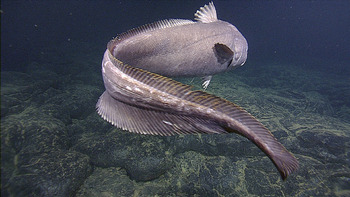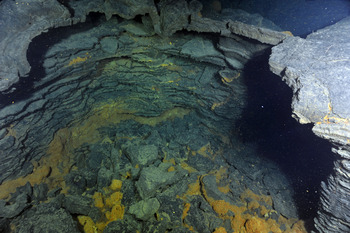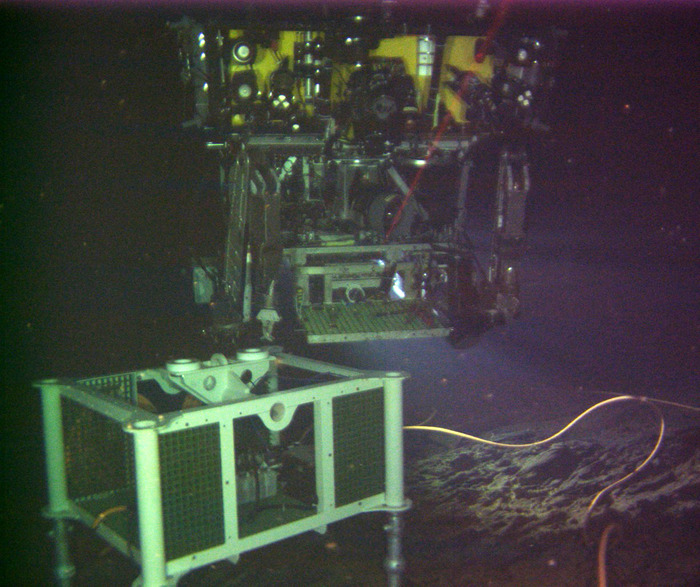During the multiple dives, we witnessed some amazing sites – the digital still camera catching ROPOS at the El Gordo vent, numerous ~ 5 ft long! rattail fish

A huge rattail, ~ 5 feet in length, swims slowly in front of the ROV ROPOS near the International District Hydrothermal Field at a depth of 5000 ft beneath the ocean's surface. This area has a higher abundance of these fish than observed elsewhere in the caldera, perhaps because of the larger size of the vent field and hence food source.

Collapse basins marked by columns, drainback features, and arches are common features in areas where lava ponded and spilled rapidly over the seafloor in 2011. A small, 1-day old chimlet sprouts from the 280°C, gas-rich vent called Dive in the International District Hydrothermal Field. NSF-OOI/UW/ISS; Dive R1839; V15.
For the past two days, ROPOS has been delivering and recovering instruments to the International District Hydrothermal vent field at Axial Seamount. Work at this site is complete, except for on instrument that may go in tomorrow. All instruments, which includes an in situ mass spectrometer, digital still camera, fluid and microbial DNA sampler, chlornity sensors and various temperature probes have fired up from Seattle and are talking back to shore during the testing phase of this program.
During the multiple dives, we witnessed some amazing sites – the digital still camera catching ROPOS at the El Gordo vent, numerous ~ 5 ft long! rattail fish that often came into the area as the ROV was working, beautiful tube, palm and scale worms waving in the warm and nutrient hydrothermal fluids, and spectacular landscapes of huge collapse zones marked by bathtub rings indicating lava drain out and several foot tall isolated columns and glistening glassy young lava flows from the April 2011 eruption.
During the latter part of the dive, we explored the rift system that fed the 2011 eruption west of the International District. Because this area is so close to the installed infrastructure, we explored this area to find out of it was perturbed by the April 24, 2015 eruption – luckily it was not. We went down into collapse pits and drove over flat runways of glassy, solidified lava called sheet flows. The ROV explored a remarkable site called Skadi’s Cauldron, which was a place where billions of microbes and their byproducts were streaming from holes in the seafloor – forming snowblowers. Of great surprise was that this site was still slightly active – 4 years after the eruption. It also is now home small patches of bacterial mats inside the caverns and several healthy tubeworm bushes adjacent to the collapse zones.
Tonight we visit the base of the volcano to swap out a junction box and take water from >9000 ft beneath the ocean’s surface.


